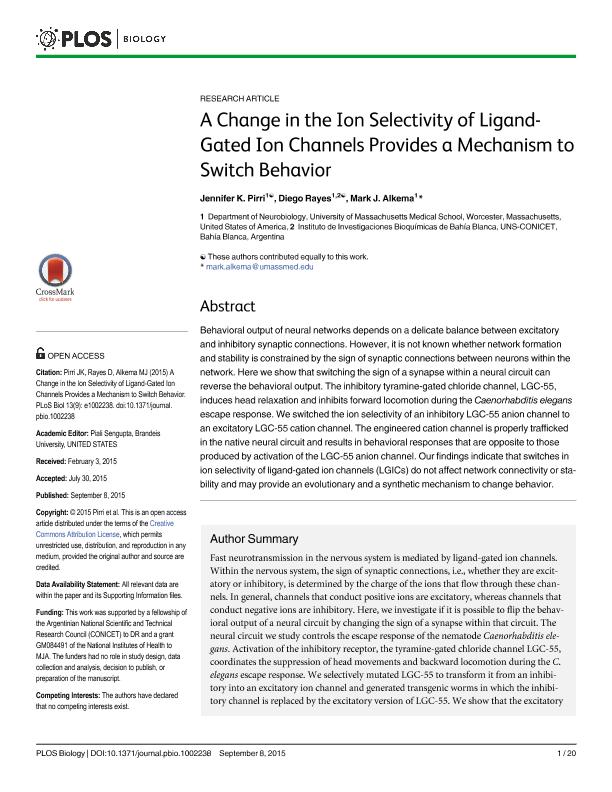Mostrar el registro sencillo del ítem
dc.contributor.author
Pirri, Jennifer
dc.contributor.author
Rayes, Diego Hernán

dc.contributor.author
Alkema, Mark J.
dc.date.available
2016-02-29T19:36:19Z
dc.date.issued
2015-09
dc.identifier.citation
Pirri, Jennifer; Rayes, Diego Hernán; Alkema, Mark J.; A change in the ion selectivity of ligand-gated ion channels provides a mechanism to switch behavior.; Public Library Of Science; Plos Biology; 13; 9; 9-2015; e1002238
dc.identifier.issn
1544-9173
dc.identifier.uri
http://hdl.handle.net/11336/4541
dc.description.abstract
Behavioral output of neural networks depends on a delicate balance between excitatory and inhibitory synaptic connections. However, it is not known whether network formation and stability is constrained by the sign of synaptic connections between neurons within the network. Here we show that switching the sign of a synapse within a neural circuit can reverse the behavioral output. The inhibitory tyramine-gated chloride channel, LGC-55, induces head relaxation and inhibits forward locomotion during the Caenorhabditis elegans escape response. We switched the ion selectivity of an inhibitory LGC-55 anion channel to an excitatory LGC-55 cation channel. The engineered cation channel is properly trafficked in the native neural circuit and results in behavioral responses that are opposite to those produced by activation of the LGC-55 anion channel. Our findings indicate that switches in ion selectivity of ligand-gated ion channels (LGICs) do not affect network connectivity or sta- bility and may provide an evolutionary and a synthetic mechanism to change behavior.
dc.description.abstract
Author Summary
Fast neurotransmission in the nervous system is mediated by ligand-gated ion channels. Within the nervous system, the sign of synaptic connections, i.e., whether they are excit- atory or inhibitory, is determined by the charge of the ions that flow through these chan- nels. In general, channels that conduct positive ions are excitatory, whereas channels that conduct negative ions are inhibitory. Here, we investigate if it is possible to flip the behav- ioral output of a neural circuit by changing the sign of a synapse within that circuit. The neural circuit we study controls the escape response of the nematode Caenorhabditis ele- gans. Activation of the inhibitory receptor, the tyramine-gated chloride channel LGC-55, coordinates the suppression of head movements and backward locomotion during the C. elegans escape response. We selectively mutated LGC-55 to transform it from an inhibi- tory into an excitatory ion channel and generated transgenic worms in which the inhibi- tory channel is replaced by the excitatory version of LGC-55. We show that the excitatory version of LGC-55 is properly localized to the postsynaptic compartments, is activated by the natural ligand, and does not affect network connectivity or stability. However, its expression leads to behavioral responses that are opposite to those produced by activation of the native inhibitory channel. We propose that switching the sign of a synapse not only provides a synthetic mechanism to flip behavioral output but could also be an evolutionary mechanism to change behavior.
dc.format
application/pdf
dc.language.iso
spa
dc.publisher
Public Library Of Science

dc.rights
info:eu-repo/semantics/openAccess
dc.rights.uri
https://creativecommons.org/licenses/by-nc-nd/2.5/ar/
dc.subject
C. Elegans
dc.subject
Behavior
dc.subject
Neural Circuit
dc.subject
Synaptic Engineering
dc.subject.classification
Biología

dc.subject.classification
Ciencias Biológicas

dc.subject.classification
CIENCIAS NATURALES Y EXACTAS

dc.title
A change in the ion selectivity of ligand-gated ion channels provides a mechanism to switch behavior.
dc.type
info:eu-repo/semantics/article
dc.type
info:ar-repo/semantics/artículo
dc.type
info:eu-repo/semantics/publishedVersion
dc.date.updated
2016-03-30 10:35:44.97925-03
dc.journal.volume
13
dc.journal.number
9
dc.journal.pagination
e1002238
dc.journal.pais
Estados Unidos

dc.journal.ciudad
San Francisco
dc.description.fil
Fil: Pirri, Jennifer. University Of Massachussets. Medical School. Department Of Neurobiology; Estados Unidos
dc.description.fil
Fil: Rayes, Diego Hernán. Consejo Nacional de Investigaciones Científicas y Técnicas. Centro Científico Tecnológico CONICET Bahía Blanca. Instituto de Investigaciones Bioquímicas Bahía Blanca (i); Argentina
dc.description.fil
Fil: Alkema, Mark J.. University Of Massachussets. Medical School. Department Of Neurobiology; Estados Unidos
dc.journal.title
Plos Biology

dc.relation.alternativeid
info:eu-repo/semantics/altIdentifier/doi/10.1371/journal.pbio.1002238
dc.relation.alternativeid
info:eu-repo/semantics/altIdentifier/doi/http://dx.doi.org/10.1371/journal.pbio.1002238
dc.relation.alternativeid
info:eu-repo/semantics/altIdentifier/url/http://journals.plos.org/plosbiology/
Archivos asociados
